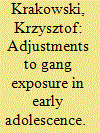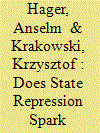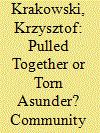| Srl | Item |
| 1 |
ID:
185187


|
|
|
|
|
| Summary/Abstract |
The article investigates how exposure to gang-affiliated peers affects social behaviors and attitudes of early adolescents. Much of the literature finds that exposure to gangs contributes to adolescents’ antisocial behaviors. According to other studies, however, gang exposure can also promote prosocial behaviors. The present article re-examines this contradictory evidence, exploring potential complementarity of both reactions to gangs. Using a survey of 1,782 adolescents aged ten to 13 from rural Colombia, I compare adolescents who are and are not in a school class with members of youth gangs. I exploit the fact that schools in rural Colombia are unsegregated. Moreover, the presence of youth gangs across these schools is linked to incidence of historic armed conflict rather than typical forms of social disadvantage. This comparative setting thus allows me to establish an unconfounded relationship between exposure to gang-affiliated classmates and social outcomes. The analysis reveals gender differences in the effect of youth gang exposure. I find that girls react to male gang classmate by increased involvement in prosocial organizations. Boys, by contrast, adjust to male gangs by expressing more antisocial attitudes. There are no gender differences in the effect of gang classmates on alcohol consumption (an indicator of antisocial behavior). The article shows that the well-documented antisocial adjustments to gangs are – population-wide – complemented by prosocial adjustments, with gender being a key moderator. I discuss the implications of these findings for theories of violence and social change after conflict.
|
|
|
|
|
|
|
|
|
|
|
|
|
|
|
|
| 2 |
ID:
185020


|
|
|
|
|
| Summary/Abstract |
Does physical surveillance hinder or foster antiregime resistance? A common view holds that surveillance prevents resistance by providing regimes with high-quality intelligence on dissident networks and by instilling fear in citizens. We contrast this view using formerly classified data from Communist Poland. We find that communities exposed to secret police officers were more likely to organize protests but also engaged in less sabotage. To ensure that the relationship is causal, we use an instrumental variable strategy, which exploits the exogenous assignment of Catholic “spy priests” to local communities. To trace the underlying mechanisms, we draw on qualitative interviews and archival sources. We document that Poland’s comprehensive use of surveillance created widespread anger as well as an incentive for citizens to reveal their true loyalties, thus facilitating antiregime collective action. Once on the streets, protesters refrained from sabotage to signal their political motivation to bystanders and authorities alike.
|
|
|
|
|
|
|
|
|
|
|
|
|
|
|
|
| 3 |
ID:
173139


|
|
|
|
|
| Summary/Abstract |
Evidence on the consequences of war for community cohesion is mixed, pointing to both positive and negative effects of conflict. This study examines symmetry of force between warring actors as an explanation of heterogeneous conflict effects. Using survey data from 224 Colombian villages, I compare cohesion in communities exposed to asymmetric and symmetric conflicts, a guerrilla war between rebels and the state and a more conventional war between rebels and paramilitary groups, respectively. I find that symmetric war increases participation in community organizations, while asymmetric war decreases trust. Evidence suggests three mechanisms that explain these findings. Symmetric war increases cohesion (i) by spurring individuals to band together to cope with significant disruption of services and (ii) by strengthening group identities that map onto fairly clear wartime cleavages. Asymmetric war reduces cohesion (iii) by instilling fear and suspicion linked to wartime experiences of civilian collaboration and denunciations.
|
|
|
|
|
|
|
|
|
|
|
|
|
|
|
|